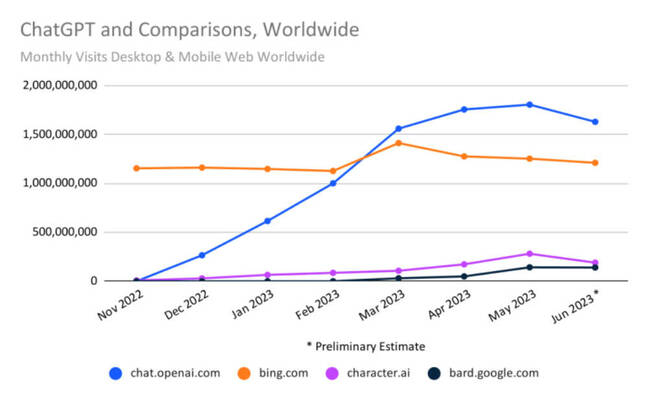Global traffic to OpenAI’s ChatGPT website fell by an estimated 10 percent between May and June, marking the first time the number of visitors to the conversational large language model has decreased since it was launched in November.
The text-generation tool quickly went viral and was said to be the fastest-growing web app in internet history, attracting 100 million monthly active users by January 2023, according to data collected by analytics biz Similarweb.
Although OpenAI and rival AI businesses had developed other large language models, ChatGPT was free, seemingly quite capable, and was widely accessible. Netizens flocked to the site, experimenting with the software and asking it to generate all sorts of text like emails, essays, or code.
ChatGPT propelled the hype behind generative AI to new heights; its ability to carry out general natural language tasks such as question and answering, and summarization captured imaginations and led to a new wave of chatbot applications. But the latest data from Similarweb suggests the initial excitement for ChatGPT is beginning to die down.
In June, worldwide traffic from desktop and mobile to the bot’s website dropped by 9.7 percent compared to the previous month, said Similarweb. In the US, it decreased by 10.3 percent. Similarly, the number of unique visitors around the globe declined by 5.7 percent. Users are also spending less time interacting with ChatGPT, too, with engagement decreasing by 8.5 percent in May compared to the previous month.
“ChatGPT no longer looks like it will keep growing until it’s the most-trafficked website in the world,” according to Similarweb. “In other words, Google is in no danger of being eclipsed by the OpenAI tech demo site that turned into a cultural phenomenon.”
ChatGPT gets more traffic than Microsoft’s Bing AI internet search bot, and Character.AI, the second most popular standalone AI chatbot site, which has also experienced a 32 percent decline compared to the previous month. We note that Google’s Bard is slowly creeping up in usage.
It’s difficult to say whether it’s a sign that the chatbot craze is fizzling out, considering there isn’t enough data from other developers and that apps from startups including Inflection.AI are just beginning to take off. A decrease in time spent on ChatGPT’s website may not necessarily mean people are less interested, either, rather that users are perhaps getting better at prompting it to carry out a specific task and are spending less time exploring its capabilities.
OpenAI’s models, including its GPT series, are available via APIs and Microsoft Azure, and so a drop in ChatGPT’s website use may be due to people moving to programmatic interfaces.
There’s also the fact that, at least in the USA, schools closed for summer around June, and one big use of ChatGPT is answering homework questions. With kids suddenly more focused on Minecraft than ChatGPT, as Google Trends suggest, that may help explain a decline in usage of the bot’s website.

Graph from Google Trends showing growing interest in Minecraft and the opposite for ChatGPT from the start of June … Click to enlarge
Interestingly enough, Microsoft’s search engine Bing, which reinvented itself with OpenAI’s GPT-4 model offering answers to users’ queries, is currently cruising at 8.7 percent of the global desktop search market, according to StatCounter, up from 6.8 percent in May. Google dominates desktop and mobile with 84 percent and 96 percent, respectively. The new AI-powered Bing is accessed via Microsoft Edge, which in June had 11 percent of the global desktop browser market, which is about where it’s been hovering for the past year. The leader Chrome slipped to 61 percent from May’s 66 percent, seemingly due to other browsers, such as Apple’s Safari, enjoying an uptick.
Downloads of the standalone ChatGPT app and ChatGPT-powered Bing app are said to be down, too, which one might expect.
As for the next step, OpenAI announced that its latest and most powerful large language model GPT-4 is now generally available to all of its customers paying for API access, as are GPT-3.5 Turbo, its text-to-image model DALL·E, and its speech-to-text system Whisper. Some of its older GPT-3-based models will be retired and replaced with newer systems by January 4, 2024. ®








